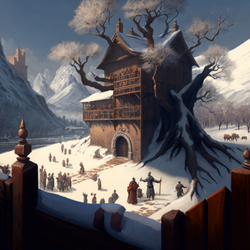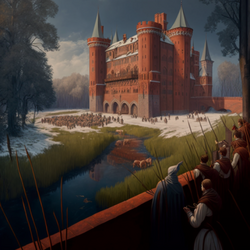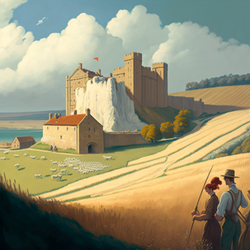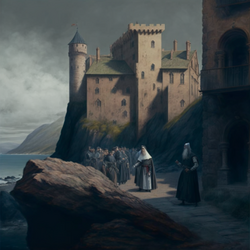More actions
mNo edit summary |
mNo edit summary |
||
| Line 114: | Line 114: | ||
|Processors = | |Processors = | ||
}} | }} | ||
[[category:Organizations]] [[category:Knight Orders]] | |||
Revision as of 21:01, 25 December 2022
| Bloodcast Order | |
|---|---|
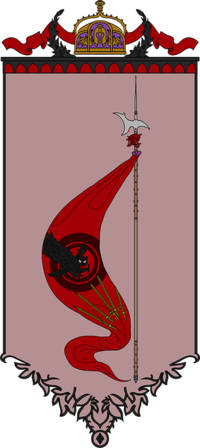 | |
| Order | |
| Pronunciation | Blood-cast |
| Origins | City of Regalia |
| Grandmaster | Council of Elders |
| Symbols | Colors Black and Crimson Red, Five Golden Swords, Black Owl |
| Colors | Black and Crimson Red |
| Race Limits | None. |
| Magic Usage | Permitted, but severely frowned upon. |
The Bloodcast Order is the youngest Knight Order within the Regalian Empire (but not strictly the youngest in receiving a Charter, which would be the Herebrand Order). It is a direct successor of the Viridian Order (that nonetheless still exists) as a protest and counter movement to everything the Viridian Order stood for. The Bloodcast Order is often described as an order of hedge Knights by outsiders, and taken less seriously than the other Orders due to its very distinct lack of societal obligations. While the Villiers protect the clergy and holy sites, the Viridians protect the government and the nobility, and the Aelrrigans protect Mages and Artifacts, Bloodcasts don’t really protect anything but their own reputation and ego. While this invariably gives them more flexibility than all the other Knight Orders, it also means that their Knighthood is taken less seriously across the Empire, or indeed at the Palace. Still, the Bloodcast Order is the largest of the Knightly Orders, and they have faithfully supported the Empire’s growth since their inception in 122 AC, and continue to do so up to this day, when the other Knight Orders receive increased public scrutiny for their above-the-law attitudes, while the Bloodcast are endeared more for being closer to the people.
Core Identity
The Bloodcast Order is a Knightly Order that stands foremostly for the platonic ideal of Knights, strong warriors who defend the weak and the poor from unlawful abuse and mistreatment, no matter where it comes from. They exercise this more strictly than the other Knight Orders, which sometimes even gets them at odds with the other Knight Orders, especially the Viridians, as they are more likely to side with the poor and huddled masses in criticizing the government for their poor conditions than defending the government from said criticism. In this lies also the second point of Bloodcast identity, in that they are a counter-movement to the rigidity of other Knight Orders, considering them mostly just extensions of the reinforcement of the status quo and structures that permit abuse without recourse such as the power of the clergy and the nobility. It is important to note they aren’t strictly against nobility and clergy, far from it as they are also part of the Imperial system, but rather they want a system in which some of these elements can be confronted and called out.
Public View
Bloodcast Knights have very mixed reception among the various social classes. Among the nobility and other Knights, Bloodcast Knights are considered lower class Knights, hedge knights with no masters and more like upsets to the natural order of things. Among the commoners, Bloodcast Knights enjoy more support, as they are generally considered more benign to commoners than yet another arm of the law to push them down, but in doing so even the common folk know that Bloodcast Knights have no strict code to abide by, and that the Order’s members are usually a very mixed bag in terms of their moral adherence to ethics. Many Bloodcast Knights are in fact just glory hounds, and the people know this.
Common Knights Code
The Common Knights Code applies to all Regalian Knight Organizations, but is also mentioned specifically on each Order page for reference. This Common Code is additional to the Bloodcast Knight Functions. It is however important to note that the Bloodcast Order applies extreme nuance to these Common Knights Codes, and has internal logic for when they no longer apply, unlike the other Orders. For each rule and how far its application stretches, there is a second line underneath explaining.
- Knights are expected to be loyal to the Emperor and the Empire without complaint. Unionism is not required, but obedience to the Crown is.
- For the above rule, it is important to note that the Nobles and Clergy are not the Empire. They are just a subservient part of it, and don’t need to be obeyed.
- Knights are expected never to attack the unarmed and defenseless, and to not resort to dirty fighting tricks or attack others from behind.
- For the above rule, it is important to note that winning an Oath-duel is paramount to even fighting dirty, these rules go out the window during an Oath-duel.
- Knights are expected not to complain, moan, or self-deprecate, Knights should never degrade themselves or be an annoying bore.
- For the above rule, this rule is more strict. It does not only extend to themselves, but also to others around them, who they should punish for self deprecation.
- Knights are expected to follow the laws of the land and not become a Criminal. They should assist Guards in apprehending criminals.
- For the above rule, Bloodcast Knights should actually determine if a criminal is hunted for tyrannical reasons, and provide assistance to the criminal if they are.
- Knights are expected not to lie, but never express every truth that needn’t be known. Knights should not deceive unless for the greater good.
- For the above rule, Bloodcast Knights can even lie for the smaller good, but only to assist someone who is being oppressed, never for themselves.
- Knights are expected to give alms to the poor and care for the needy, and to protect those who cannot protect themselves, and punish dishonor.
- For the above rule, Bloodcast Knights are expected to even protect those who can protect themselves, but are fighting impossible odds against a cruel foe.
Bloodcast Knight Functions
Order Functions are a set of roleplay goals and activities that one can engage in while being a Bloodcast Knight. These are functions more-so than rules, but some rules are implied in the functions. For example, while Bloodcast Knights don’t need to do a whole lot, refusing to go after a Vengeance Writ or socializing with a person who has a Vengeance Writ against their name, would be violating their honor code. It should also be noted that Bloodcast Knight Functions are incredibly short in comparison to other Knight Orders. This is because Bloodcast Knights have a lot more individual freedom and less expectation of strict rule adherence. This freedom comes at the cost of tangible function in society.
- Bloodcast Knights, when defeated either in single or multigroup combat by any one person other than their own, are expected to publicly declare a Vengeance Writ against such a person to signal all other Bloodcast Knights that they should seek out this person and Oath Duel them to wash away the dishonor of defeat of another sibling in arms.
- Bloodcast Knights are expected to keep a watchful eye over the corruption of the Nobility, and make public their misdeeds and foul intentions when some are found. This often puts them in direct conflict with Viridians who defend the nobility. Public accusations should be filled with fact, and to the point of seeking redress not shame.
- Bloodcast Knights are expected to try and seek ways to out-do or upstage other Knight activities to show that Bloodcast Knights are always better. Whether this involves capturing a Demon that Viridians cannot, or showing their superior combat skills over an Aelrrigan so that the Bloodcast Order may always be seen as the most skilled.
- Bloodcast Knights are expected to make the people understand the practical benefits to being loyal to the Emperor, but also teach them a cynical and critical view of the Emperor’s administration, believing that the Emperor is always surrounded by selfish and greedy politicians who abuse the Emperor’s good nature for personal gain.
- Bloodcast Knights are expected to hold Oath Trials in which they perform a mock trial against an absent (or present?) politician to discuss their failures in office and judge them worthy or unworthy of their station. These should always be public to the people, full of fact, and more about giving second chances with advice than just ridicule.
- Bloodcast Knights are expected to generally not be exceedingly wealthy, show opulence, or be part of the same ruling classes that the Order routinely criticizes. This doesn't mean they aren't allowed to be aristocrats, but rather that they should decline higher titles and behave inscrutably as members of the peerage held to a higher standard.
Privileges
Bloodcast Knights have specific legal privileges that remain active so long as they are not disgraced. A Bloodcast may become disgraced by part of backstory writing, or in roleplay because they break the Knight’s Code and are found guilty of treason within the Order. There is no further civil prosecution of a Knight for being expelled, but they do lose all privileges. Some privileges require higher ranks. In order to be approved for higher ranks, consult a Discord Ticket for accessibility.
- Swordsworn and up have automatic rights to wear armor up to plate quality in the city.
- Swordsworn and up have automatic rights to bear arms of any kind in the city, and even open-carry such weapons. They must however stand down if commanded by Metropolitans.
- Swordsworn and up have automatic rights to call for a Vengeance Writ or Oath Trial against any public figure, making use of their own channels to spread the word.
- Only Glorysworn have automatic rights to receive a Knightly Manor in the Noble District. This Estate is not as large as a Noble Estate, but provided for free in Uptown.
Vengeance Writ
To the Bloodcast Order it is important that Bloodcast Knights do not become seen as average joes and janes, or people who can just get stepped on without any sort of consequences. If a Bloodcast Knight is defeated in any type of combat, the victor (the person landing the last blow) is declared a Vengeance Writ against. While a person is under Vengeance Writ, any and all Bloodcast Knights must track down this person, and challenge them to an Oath Duel, and if they systematically refuse, attack them on sight, until they are defeated. If someone already has a Vengeance Writ to their name, they cannot be extra written for defeating any Knights sent after them. If they are defeated by a Knight one way or another, the Vengeance Writ is nullified. Oath Duels are always one on one and the Bloodcast Knight should respect this, but if the Oath Duel is denied, Bloodcast Knights are permitted to goon-squad the Vengeance Writ person, even with outsiders who are not Bloodcast Knights.
Oath Trial
Oath Trials are unofficial acts of public discourse on the performance of a state Minister or politician (it can never target a royal family member). During an Oath Trial, the Bloodcast Knights organize a public gathering somewhere unofficial, like the festival grounds or a patch of grass in the park, or the All-Faith Arena and sit among the audience in a circle to debate the skill and efficacy of the politician in question. The politician is always given an invitation to show up, but doesn’t have to, because Oath Trials have no legal bearing, and are usually just kangaroo courts of people who don’t like said politician. During an Oath Trial, the Bloodcast Knights hear the complaints of the common people, and reinforce them with supplemental information of their own. At the end of the trial, they declare a political person unfit for office, or fit for office. The whole trial is still meant to be fair and not just a public complaining session, unproven facts or information should be rejected, and the goal should always be restitution and challenging the politician to do better, not to have them killed or removed. One of the Knights should record the Oath Trial and publish the information in an open letter to the people of the Empire on notice boards.
Structure
The Bloodcast Order has a hierarchical structure that defines the ranks within their Order.
- The Bloodcast Council is the ceremonial leader at the top, always the five oldest Bloodcast Knights alive, this rank is reserved for Event NPC’s.
- The Great Bloodcast are the retired instructors and teachers who essentially rest in waiting to become Bloodcast Council members, they are Event NPC.
- The Journeyman Knights are highest ranked Bloodcast Knights who roam the world and have legendary fighting skills, they are Progression Event NPC.
- The Glorysworn Knights are higher ranked Bloodcast Knights with special privileges in Regalia that require review from Lore Staff.
- The Swordsworn Knights are the rank and file Knights of the Bloodcast Order that most players start at when making a Bloodcast.
Order Chapterhouses
Bloodcast Chapterhouses are specific castles where the Order is permitted to take in and train new recruits. Bloodcast recruits, unlike other Knight Orders, can be taken in at any age and trained, though they consider 50 too old, and anything younger than 13 too young. The most common age to be taken in and trained is 13, and training usually takes 8 years. The Bloodcast Order very commonly takes in orphans or young pages who were recruited by Bloodcast Knights in the field because they saw something in their fighting spirit, or their talent for becoming a warrior.
| Name | Description | |
|---|---|---|
|
The Greak Oak Chapterhouse is in Drixagh, of all places, in a small town called Voldaberg nestled between two mountains that are nearly permanently cast in snow. The Great Oak Chapterhouse is dominated by Old Gods Bloodcast Knights, but curiously enough, also Velheim recruits who have opted for a more regalian centralized Knighthood lifestyle, over the more traditional Skagger learning. The Greak Oak Chapterhouse is not very popular among the locals, but it trains some of the most skilled Great Oak Bloodcast who use axes, maxes, and occasionally sword and shield (though really, they can train with any weapon). The notable thing about this castle, is that it is built on top of a massive cow-barn made of stone, where they house the huge herd of cattle that they use to feed the locals, and the fact that the castle itself is built around a Great Oak, a venerable tree that stands towers above all other trees in the area and holds a spiritual meaning to the Old Gods faithful. Great Oak Bloodcast Knights are known as more glory-seeking than the other Knights, who frequently go on hunts with their fellow Knights to slay great beasts or monsters in the provinces. | ||
|
The Oxfurd Chapterhouse in Rosendale was the first and foremost important of the Bloodcast chapterhouses near the city of Oxfurd. The castle itself is sometimes also called the red citadel, notably because it was the site of one of the bloodiest battles during the Baron's rebellions in then Dragenthal. The Barons which revolted against the noble rulers of the land laid siege to the castle, where the Knights sallied forth and defeated the Baron's Army which was five times larger in a desperate battle. This time in history is still complicated, because the Barons had a just reason for their revolt in the eyes of the Bloodcast, but they also couldn't accept the slight of the Baron's Army's intention to loot the Oxfurd chapterhouse and demolish it as they demanded there be no castles in Rosendale with which to oppress the freedoms and rights of the Barons. The Oxfurd Chapter Bloodcast Knights are known to be the more experimental of the Order, as this castle in particular has started flirting with the idea of giving training lessons in firearms, breaking the mold of the traditional knight with sword and shield, though that is also still plentifully trained here. | ||
|
Wit Uilenburg (translated to White Owlcastle in Common) is the chapterhouse of the White Owl Bloodcast Knights situated on the coastline near Uilenburg in the south of Anglia, in a region called Lokinge. Wit Uilenburg is known far and white for the porcelain white cliffs in the area, and the mountain which it is built on, contrasting with the golden wheat fields nearby and the sandstone exterior of the castle. Wit Uilenburg's Knights are known to be the most gregarious and sociable of all the Bloodcasts, this castle being a feasting hall for the locals where constant social exposure and extrovert behavior are encouraged. There is a saying in Anglian that "Never did Uilenburg create one with deed or mouth so foul it feeds the virtue of crop and lamb", in reference to the warm generosity between the people and the Knights of the Castle. Uilenburg is also an oddity in that it is placed in very xenophobic Anglia, but accepts students and trainees more widely than the local population normally would, thus being a small beacon of multicultural acceptance in an otherwise Anglian dominated area. Uilenburg Bloodcast Knights are frequently trained in the use of bows and crossbows, in particular the Anglian Longbow, though regular melee weapons are also still common. | ||
|
The Fenn Mohér Chapterhouse is situated on top of a lost Aelrrigan Magivault near the town of Fenn Cannys on the southern coast of Anglia. This castle has quite a complicated history, because one would not expect the Bloodcast to exist in an Aelrrigan dominated province, let alone on top of one of their Magivaults. The story goes that Fenn Mohér was once an Aelrrigan Castle, but the Lord of the castle offended the Bloodcast Knights so that they laid siege to it, defeated the Knights and laid claim to it, all the while not killing a single Aelrrigan, instead using restraining weapons, and letting them go after the fight was over. The Magivault was claimed by the Bloodcast Order and has been under their protection ever since, an open taunt to the Aelrrigans who still claim the castle as theirs. Fenn Mohér Bloodcast Knights are known as more soft on the Occult, and it is also the only Bloodcast castle that has a few Magic instructors, even though the Order still strongly discourages the use of Magic as an inherent weakness in reliance on one's own skills and body. An acceptable form of Magic that is taught here is Magic that purely affects the weapons wielded by the Knights or fortifies their armor, for example lighting their weapon on fire, or causing their armor to have a chilling effect. It's Knights never use ranged Magic or curses on people. | ||
History
Bloodcast Order history is surprisingly simple, and concise. The order officially started in 122 AC, during the Viridian Coup attempt. Five Viridian Knights defied the other Viridian Knights who intended to imprison Emperor Henri III and usurp the throne, by riding to the Emperor and warning him. On their way to the castle, the five Knights were attacked by their fellow brothers in arms, but were victorious and rode on to the Palace to warn the Emperor, which would eventually lead to the rounding up and execution of the Viridian Knights who plotted treason. The five Knights, after having been attacked and riding to the Emperor, rode with their usual green capes covered in blood, hence becoming red. They then swore an oath to do better than what the Viridians had, and Emperor Henri III gave them the rights to found a new Knighthood Chapter, ostensibly to compete with the Viridians who were already severely reduced in power, but also to cover the blind spots the Viridians could not in society. Those five ex-Viridians thus founded the Bloodcast Order, became its first teachers and Elder Council, and lead the order until the last of them Councilmaster Henry of Benteford died in 167 AC. The Order's history has otherwise been somewhat unremarkable. They have been present in every single war and conflict Regalia has been in, though always less visible than the Viridians who seize the moment and the limelight. They have been involved in many of the greatest arrests in Regalian law enforcement, but always bow out at the end so as to avoid being involved in the regime's repression efforts on those who were guilty by association. Many Bloodcast Knights go about their lives remaining largely unknown to the people, wandering the roads in the countryside to offer help and support to areas and peoples that the Viridians are too good for, the Villiers are too godly for, and the Aelrrigans too busy for. Bloodcast Knights remain easily recognized in the street due to the fact that they all wear either a crimson red cape or shoulder capelet, identifying them as a member of the order, even without armor or weapons on them.
Trivia
- It is not formally possible to be expelled from the Bloodcast Order, though it is possible to lose public privilege in Regalia. That is to say, one always remains a member of the Bloodcast Order, but the right to bear arms and armor or fight alongside the law in Regalia can be revoked, thus losing Knighthood status in all but name.
- It is actually possible for Villiers, Aelrrigans or Viridians who were specifically disgraced from their respective orders to become Bloodcast, though such a request should always be approved by the Council after a fair trial to judge their crimes to their respective Orders, and see if they would fit in with the Bloodcast.
- It is seen as disgraceful among the nobility to send their children to the Bloodcast Order, as the Order is not considered in Imperial respects. However, some poor Noble families or less well-off have no other options, as Viridian training is prohibitively expensive and usually comes with the expectation of life-long donations to the Order.
| ||||||||||||||||||
| Accreditation | |||||||
|---|---|---|---|---|---|---|---|
|
| ||||||
